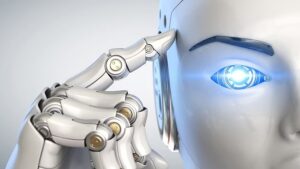AI and machine learning used to be relegated to science fiction. But in recent years, it has become real and a part of all our personal and professional lives. Voice assistants help us find the information and products we need, and self-driving cars can (in theory) take over when we are distracted. Machine learning is definitely transforming the world. At the forefront of this change is the machine learning engineer.
But what does a machine learning engineer do? In this article, we’ll explore the machine learning engineer job description, the skills and knowledge required for the role, and how you can become a machine learning engineer yourself.
Let’s dive in and learn more about this exciting and rapidly evolving field.
What Is a Machine Learning Engineer?
Machine learning is a branch of computer science and AI that uses data, specialized algorithms, and models to simulate how humans learn. These models use the data on past events to determine how future events are likely to occur, gradually improving accuracy over time. Machine learning engineers design, build, test, and deploy these machine learning models.
They are involved in every step of the machine learning process, from preparing data and extracting features to building and perfecting the models. They work with other data and technical professionals like data analysts and software engineers to implement complex machine learning solutions, and they collaborate with business leaders to determine which business problems are best suited to a machine learning approach.
Also Read: What Machine Learning Skills Are Companies Looking For?
Machine Learning Engineer Roles and Responsibilities
The duties of an ML professional may vary depending on the specific machine learning job description, but generally, they are responsible for the following tasks:
Data Preparation and Analysis
Machine learning engineers must have strong data preparation and analysis skills to understand large datasets, preprocess them, and extract features from them. They usually work with a team of data analysts and data scientists to determine which types of machine learning models will work best for the business requirements and which data types are most important for gaining the insights they seek. They then collect and prepare the data to be used with the models.
Model Building and Optimization
Machine learning professionals use the data to train predictive models once the data has been prepared. They may test various models based on the problem they are working on and analyze their performance to determine which will provide the most accurate results. They also fine-tune the models by adjusting hyperparameters, like learning rate and regularization, to improve their accuracy further.
Model Deployment and Monitoring
The next step in the machine learning process is deploying the final models to production. In the production environment, the models are connected to other software applications that will use their predictions to automate manual processes. Machine learning engineers monitor the performance of these models to ensure they are working correctly and make adjustments to keep them relevant.
Collaboration and Communication
Most ML engineer job descriptions aren’t entirely technical. These professionals must also have some people skills because they work with product managers and other stakeholders who may not be as technical as they are. That means they must have sufficient communication skills to explain complex machine learning concepts in a way non-technical team members can understand.
Also Read: Machine Learning Engineer Salary
Skills and Qualifications of a Machine Learning Engineer
Machine learning engineering is a complex and challenging field that requires a diverse set of skills and qualifications. Here are some of the essential skills and qualifications needed to meet the requirements of a machine learning engineer job description.
Proficiency in Programming Languages
Another part of the ML engineer job description is knowing various programming languages. They will use languages like Python and Java to process data, build models, and transmit the results to other applications.
Strong Mathematics and Statistics Skills
Machine learning is based on mathematics, so a knowledge of math is essential to understanding how machine learning algorithms and models work. Machine learning engineers need an above-average knowledge of linear algebra, calculus, probability, and statistics to be successful.
Experience with Machine Learning Libraries and Frameworks
Machine learning professionals find greater success when they are familiar with machine learning frameworks like TensorFlow and PyTorch. These tools give them pre-built models and pipelines they can use to speed up the development process and get faster, easier results.
Familiarity with Databases and Big Data Technologies
Machine learning is all about data, so a machine learning engineer must know how to work with databases and big data technologies like Hadoop or Spark. These technologies enable engineers to efficiently collect, store, and process the large amounts of data machine learning models require.
Education and Experience
The education required for an ML professional varies according to the machine learning engineer job description. Most positions require at least a bachelor’s degree in mathematics, computer science, or a related field. Because it is a specialized industry, employers often prefer candidates with experience in machine learning or data science.
Also Read: Machinе Lеarning Algorithms: A Beginner’s Guidе
Machine Learning Engineer Salary and Job Demand
Machine learning engineers have been in demand for a while. According to LinkedIn, machine learning engineering is the fourth fastest-growing job in the United States, behind customer marketing manager, diversity and inclusion manager, and vaccine specialist.
How much machine learning engineers get paid depends on their skills, experience, and the job they are applying for, but most receive a six-figure salary. According to Indeed, the average base salary of a machine learning engineer in the United States is $150,186, and the salary range is from $95,337 to $236,539. But that only pertains to the base salary. ML job descriptions often include other benefits, including stock options, bonuses, insurance, a 401(k), and more. Plus, 61 percent of machine learning engineers consider their salary enough to cover their cost of living.
Also Read: How Does AI Work? A Beginner’s Guide
Highest Paying Cities for Machine Learning Jobs
Education and experience are significant factors in determining how much a machine learning engineer gets paid, but location can also affect salary. This can be due to a higher cost of living or a higher demand for AI engineers. Here are some of the highest-paying cities for machine learning engineers, according to Indeed:
- New York, NY: $193,066
- Cupertino, CA: $177,841
- San Francisco, CA: $160,113
- San Jose, CA: $159,198
- Santa Clara, CA: $157,873
- San Diego, CA: $141,094
- Pittsburgh, PA: $139,977
- St. Louis, MO: $132,026
- Reno, NV: $122,320
Machine Learning Engineer vs Data Scientist
Even in the industry, the terms “machine learning engineer” and “data scientist” are often used interchangeably. But despite the fact that both roles deal with data, they are different. Here is a comparison.
Machine Learning Engineers
The machine learning engineer job description focuses on creating, testing, and deploying machine learning models. They have highly developed software engineering and programming skills and expertise in machine learning algorithms, libraries, and frameworks.
Data Scientist
On the other hand, a data scientist extracts insights from data and uses them to inform business decisions. They know statistics, data analysis, data visualization, and data mining. They also tend to have some knowledge of machine learning algorithms, though they won’t usually have a hand in creating those models.
Key Differences
Here is how machine learning engineers and data scientists differ and what you will find in a machine learning engineer job description when you are searching.
- Machine learning engineers are more focused on the software engineering parts of machine learning, while data scientists focus more on data analysis and interpretation.
- Machine learning engineers have software engineering and programming expertise, while data scientists deal more with statistics, data analysis, and data visualization.
- Machine learning engineers are responsible for building and deploying ML models, while data scientists extract insights from data and use them to provide business insights.
Also Read: Deep Learning vs. Machine Learning: Everything You Need to Know
A Tip on How to Become a Machine Learning Engineer
Machine learning and AI took off in the last decade, giving rise to well-paying and in-demand jobs for anyone with the right skills. It can be highly rewarding to know that, as a machine learning engineer, you’re responsible for building the ML models that are revolutionizing the world. The demand for these professionals is not slowing down, and one of the best ways you can jump on it is to take an online machine learning bootcamp.
This AI ML course combines academic excellence and industry prowess in the field of artificial intelligence and machine learning. It covers topics like computer vision, deep learning, neural networks, speech recognition, and more. It will provide you with real-world, hands-on experience as you complete multiple projects in integrated labs while you learn from industry experts and experienced instructors and work collaboratively with your peers.
Who knows? Once you upskill, you might be the perfect match for many machine learning job descriptions.
You might also like to read:
Exploring AI vs. Machine Learning
Exploring Tech Innovation: What is Edge AI?
Tech Innovation Challenges: Exploring Ethics in AI






